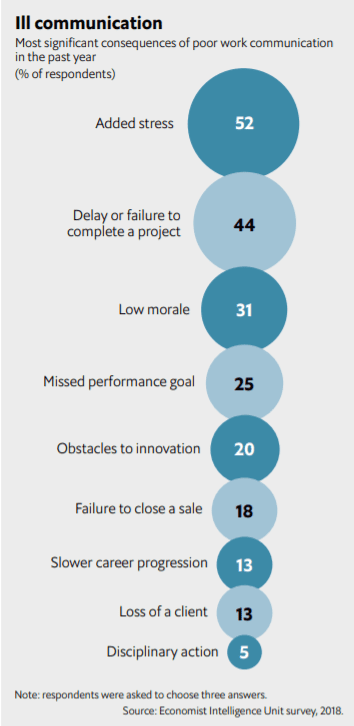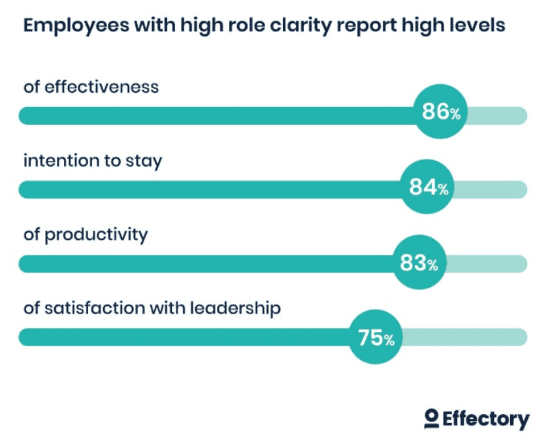A few years ago, I read a business review written by a company’s internal sales reps that really struck a chord with me — especially since I am in the business of keeping those sales reps inspired to hit ambitious sales targets.
ADT Corporation, popular for their home security services, had sales reps who publicly shared that they felt like they were treated more like secretaries than colleagues by their managers.
The sales team was fed up with leadership’s bad behavior, even leaving reviews on Glassdoor that said things like: “Keep looking. They make up the game plan as they go. They have no stability in their business methods or practices.”
It might surprise you to know that those negative in-house sentiments were not just petty, passive-aggressive grumbling – it had a massive impact on the stock price of ADT. That same year, as teams splintered and management struggled to figure out what to do, their stock dropped precipitously — costing the company billions in market value.
In truth, there are countless reasons why teams fail — including “managers who treat you like secretaries”, the inability to deal with conflict, lack of mutual accountability, and ineffective problem-solving skills. The list goes on and on.
So, let’s focus on the 4 most common realities about why teams fall apart, and what you can do to fix it.

1. A Lack of Trust Makes Your Best People Leave
Andy, a Senior Recruiter, fills positions at the largest hospital in the area. He has years of experience and a great personality which allows him to be great at his job. Managers from every department specifically sought him out to fill their positions due to his professionalism and efficiency.
Unfortunately for Andy, his boss micromanages every little thing he does. Although Andy is great at his job, he spends a large bulk of his time filling out numerous forms and metrics of his calls and is then grilled in weekly meetings about them.
Micromanaging everything he does demonstrates to Andy that his manager doesn’t trust him.
Bottom line — teams cannot function without trust.
Trust is the foundation of all successful teams. Whether it’s a sports team or a business team, it will fail without trust.
Lack of trust can lead to poor communication, lower employee engagement, reduced productivity, and lower overall morale.
There will be times when people may not see eye to eye on an issue, but if they have built trust between them, conflicts can be a healthy, productive, and positive thing.
Business leaders need to be able to create an environment that promotes trust. When you nurture a strong sense of trust in the workplace, you see a number of benefits, including:
- Increased morale
- Increased productivity
- More effective teamwork
- Better efficiency when completing projects
“Trust is not a matter of technique, but of character; we are trusted because of our way of being, not because of our polished exteriors or our expertly crafted communications.”
– Marsha Sinetar, Corporate Psychologist and Author
How can your company build trust amongst its employees?
Trust is built through actions, not words. It is difficult to measure and complicated to maintain, but worth the effort. In some cases, it can make or break an organization.
Here are 5 ideas for how leaders can build trust within their company:
- Allow your teams to make decisions. Present them with a clear endgame, but give them the space to complete it on their own. Do not micromanage. This shows you trust them to do their job and gives you more time to do yours.
- Have an open-door policy. Show your employees that their opinions matter and are valued by encouraging them to speak to you whenever they need to. Open communication leads to more productive feedback and quicker decisions being made.
- Act with integrity. Follow through on your promises and always be honest. What employees observe from their leaders, is how they predict your future behavior. You will build trust with your employees if they know you are always being truthful with them.
- Don’t show favoritism. Georgetown University’s McDonough School of Business found that 92% of senior business executives have seen favoritism in the office. Always praise your employees for a job well done, but be aware of showing partiality.
- Keep staff members informed. Knowledge is power. The more transparent you can be about all aspects of your business, the more empowered your employees will become.
Without trust, your team is destined to fall apart.

2. Unclear Communication Frustrates Everyone
Stephanie, an Executive Assistant, was hired to help the President of a large manufacturing corporation. They would have weekly meetings where her boss would ruminate on ideas throughout the entire meeting. He was always indecisive when talking about new projects.
I wonder if we should start production of the new product before the end of the year or wait? Pricing of the materials for the product change from day to day.
To Stephanie, his comments meant he was still deciding when to move forward, so she continued with her other projects. To her boss, it meant that he wanted her to price the materials for the new product.
Poor communication in the workplace can have a negative impact on productivity, morale, and teamwork. According to a study by The Economist Intelligence Unit, poor communication has a tremendous impact on the workplace.
The study states that “unclear instructions from superiors, pointless meetings, and other stressors can snowball into larger issues with widespread impact on the business.”
Respondents say poor communication leads to:
- Delay or failure to complete projects (44%)
- Low morale (31%)
- Missed performance goals (25%)
- Increased stress (52%)
- Lost sales (18%) — some worth hundreds of thousands of dollars
Different communication styles, unclear responsibilities, and time pressures are the three most frequently cited causes of poor communication, according to The Economist.

What can you do to promote better communication in your organization?
Taking the time to tailor your communication style will have long-lasting positive effects.
These simple guidelines will help you have more productive and clear communication with your employees.
- Explain why you are asking an employee to do something. When you give a task without explanation as to why it is important you will frustrate the people on your team. For work to feel meaningful, your people need to feel they are contributing to the big picture. And in doing so, you are showing the employee how their work ties directly to the business goals.
- Really listen. It is the responsibility of the person conveying the instructions to be clear in their message. But it is also their responsibility to really listen to what the other person is saying. Communication needs to be a two-way street. Encourage them to ask questions and offer their opinion.
- Understand others’ communication styles. Everyone communicates differently and as a leader, you need to be able to navigate these different personalities. Some of your team members prefer messaging with technology like Slack, while others prefer face-to-face communication. Observing or asking them directly will save a lot of miscommunication and headaches later.
- Make sure people’s roles on a project are clear from the beginning. Communication can break down quickly when employees do not have a clear understanding of their role in a project.
- Be aware of nonverbal communication. Body language, eye contact, hand gestures, and tone of voice add nonverbal meaning to the message you are trying to get across. A relaxed stance and friendly tone will show you are approachable, whereas speaking to someone with your arms crossed and with a flat tone will make you appear closed off.
Taking the time to be clear ensures your team sticks around for the long run.

3. A Lack of Training Cripples Your Growth
Jacob, your new salesman, is eager to connect with potential new clients. He tells you about several new leads he met with his first week on the job. He is excited about his success.
After meeting with him you realize the so-called leads he found were not within your market. He is immediately confused, feeling misled and frustrated.
Sending Jacob out to meet with potential customers without giving him the training he needed was a big misstep.
Employees will not understand how to correctly do their jobs if they are not given proper training. Every business is different and if you want your employees to thrive in your work environment you will need to train them.
Insufficient training can lead to an unsafe work environment, reduced productivity, unhappy employees, increased turnover, and potentially the loss of customers.
Unfortunately, many organizations see training as an expense and not as an investment. But it actually costs less to properly train an employee than to ignore it altogether.
Companies lose unnecessary time and money when they don’t train their employees. And then when they leave, it costs thousands of dollars in salary, severance, and recruitment costs to bring someone else in — who is also likely to fail because they aren’t being trained.
What are the benefits of training employees?
- Improved employee performance. Team members who receive the training they need are able to perform their job better. Training also gives them a greater understanding of what is expected of them. Workers who are more capable at their jobs are happier, more efficient, and tend to stay longer.
- Improved employee morale and satisfaction. If you invest in training, it shows your employees that they are valued and supported by the company, which translates to happier and harder working employees.
- Positive employee retention. Your staff will feel more valued if you are investing in them. Training and development of your new and current staff will give them the tools needed to perform well and potentially move up in the company. When there is the potential for growth, employees tend to stay with the company.
- Less supervision. If an employee has been given proper training, supervision is lessened. This gives leaders more time to focus on other important tasks to help the business.
- Keeping up with technology. Technology is constantly changing and your employees need to change with it. Ongoing training will ensure that employees can adapt to the latest developments in technology, allowing them to improve their job skills.
Trained employees build fast-growing teams who end up conquering the world.

4. Having Unclear Roles Guarantees Disaster
Jennifer’s company recently went through a merger with another company. There were two marketing teams, each with two managers and teams under them both. The teams were supposed to work as one.
Clear roles were not established and no one knew what the other was responsible for. So, each team continued to do what they always had. During the weekly team meeting both teams presented a marketing campaign for the same product.
Because roles were not clearly set, their effort was duplicated and a lot of hard work was wasted.
Unclear roles and responsibilities can greatly impact a company’s productivity. When it isn’t clear who is responsible for what, what is expected of that person and who needs to make decisions, things fall through the cracks.
Conflicts with other employees are often caused by a lack of role clarity. Team members are more likely to waste energy negotiating roles or protecting their turf, rather than focusing on their tasks. On the other hand, when clear roles are established, collaboration improves.

A 2018 study done by Effectory shows that employees with high role clarity report higher levels of effectiveness, intention to stay, productivity, and satisfaction with leadership.
How can your team benefit from role clarity?
- Everyone knows what they need to do. When clear roles and responsibilities are set, employees know what is expected of them.
- Projects are completed on time and done correctly. When everyone knows their role, small pieces of the project will not fall through the cracks.
- Employees work better together when everyone understands their role and the role of others. There will be fewer arguments and greater overall creativity.
- Energy is not wasted. If there is a lack of clarity, people tend to waste time and energy dealing with things that don’t matter. Knowing their role in the company allows them to focus on the task at hand.
- It opens the door for team building. When an employee feels confident in their role, they are more apt to be a better team player.
No one wants to be a part of a team that sucks. It is demoralizing and sad. The good news is that you as the leader have the opportunity to build a team that is legendary.
To do that you need to build trust, over-communicate, train your people, and help team members be clear on their roles as part of the group.











